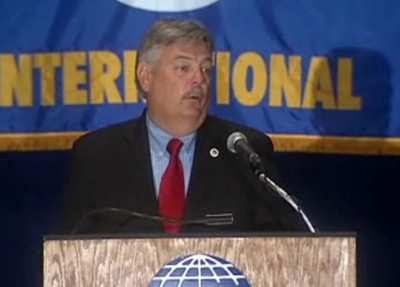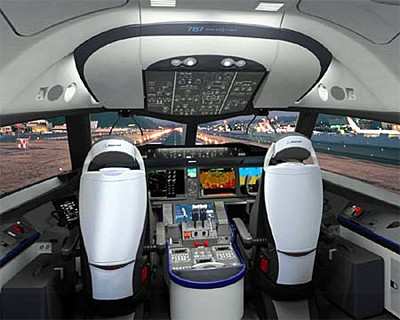ALPA Brings Pilots’ Perspective to FAA Partnership for
Safety Symposium
'Communication' was the primary topic last week as the Air Line
Pilots Association brought the views of nearly 53,000 airline
pilots to the FAA’s Partnership for Safety Symposium, and
made clear the importance of ensuring that every professional
involved in the operation of a flight adheres to the highest
possible communications standards.

“Airline pilots learn the importance of adhering to
standard procedures and phraseology in their communications and the
value of training and discipline early in their basic flight
training,” said Capt. John Prater, ALPA’s president, at
the conclusion of the FAA symposium. For professional airline
pilots, that knowledge is expanded and reinforced as new first
officers also receive mentoring from captains. “These
principles remain essential to safety no matter how experienced an
aviator becomes,” Prater noted.
ALPA maintains that throughout the national and international
airspace system, the fundamentals of undergoing thorough training,
adhering to standard operating procedures, employing standard
phraseology, and capitalizing on techniques for good radio
discipline that have been developed over decades are vitally
important. From using clearly defined call signs to accurately
understanding clearances and ensuring that all parties have a
common understanding of radio transmissions, the major topics that
were discussed at the symposium hinge on these fundamentals.
While air transportation remains extremely safe, ALPA urges the
aviation industry to continue efforts to ensure that
pilot—controller and other flight operation communications
are as relevant and accurate as possible. ALPA pilot safety
representatives participated in the FAA symposium to discuss
pilots’ concerns and best practices in communications issues
such as hear-back/read-back between pilots and controllers,
standard phraseology, similar-sounding call signs, and sharing of
critical information.

“Safety is enhanced when pilots receive as much critical
information as possible regarding runway assignments, weather,
turbulence, and other operational issues,” said Capt. Rory
Kay, ALPA’s Executive Air Safety Chairman. “Providing
pertinent information to the flight crew proactively and in advance
of critical phases of flight avoids distractions once the flight is
under way and enhances safety for passengers and crew.” ALPA
representatives underscored the need to ensure that the large
amount of information that pilots receive in the cockpit, including
NOTAMS, is prioritized and as tailored as possible to the safe
operation of the specific flight.
 “Pilots receive a huge amount of information when
planning a flight—some of which is critical to its safe
operation, while some information may not be especially relevant to
the individual flight,” Kay continued. “Pilots need the
information we receive to be prioritized so that we can quickly
determine what is of greatest importance to the safety of our
flight.” Additionally, all of the working groups highlighted
that communications can be significantly enhanced when pilots and
controllers clearly understand each other’s roles and
responsibilities. ALPA representatives were encouraged by the
universal stakeholder agreement that allowing a controller to
observe flight crew training in a flight simulator or to sit on the
flight deck during a familiarization flight ultimately increases
flight safety. Such exposure to the operational environment and the
opportunity to see how air traffic control instructions come across
in the cockpit provides invaluable insight that cannot be obtained
any other way.
“Pilots receive a huge amount of information when
planning a flight—some of which is critical to its safe
operation, while some information may not be especially relevant to
the individual flight,” Kay continued. “Pilots need the
information we receive to be prioritized so that we can quickly
determine what is of greatest importance to the safety of our
flight.” Additionally, all of the working groups highlighted
that communications can be significantly enhanced when pilots and
controllers clearly understand each other’s roles and
responsibilities. ALPA representatives were encouraged by the
universal stakeholder agreement that allowing a controller to
observe flight crew training in a flight simulator or to sit on the
flight deck during a familiarization flight ultimately increases
flight safety. Such exposure to the operational environment and the
opportunity to see how air traffic control instructions come across
in the cockpit provides invaluable insight that cannot be obtained
any other way.
“ALPA supports the FAA’s efforts to swiftly
reinstate the air traffic controller familiarization flight program
as one tool to do even more to enhance flight
communications,” said Kay. “We commend the FAA for
holding the symposium, and we look forward to continuing to work
with the aviation industry to ensure all flight communications
provide the highest level of safety possible for our passengers,
crews, and cargo.”
 ANN's Daily Aero-Term (04.20.24): Light Gun
ANN's Daily Aero-Term (04.20.24): Light Gun Aero-News: Quote of the Day (04.20.24)
Aero-News: Quote of the Day (04.20.24) ANN's Daily Aero-Linx (04.21.24)
ANN's Daily Aero-Linx (04.21.24) Aero-News: Quote of the Day (04.21.24)
Aero-News: Quote of the Day (04.21.24) ANN's Daily Aero-Term (04.21.24): Aircraft Conflict
ANN's Daily Aero-Term (04.21.24): Aircraft Conflict





